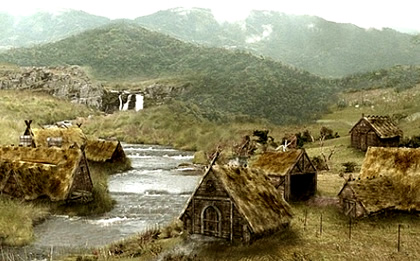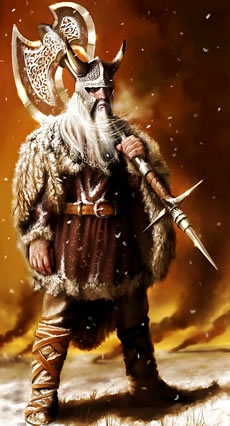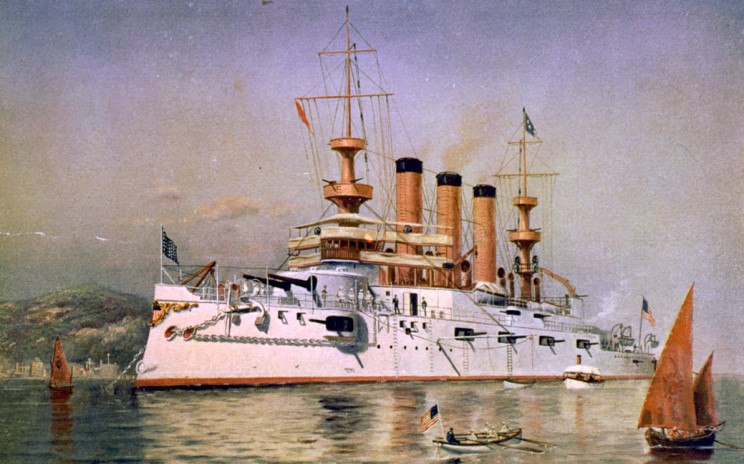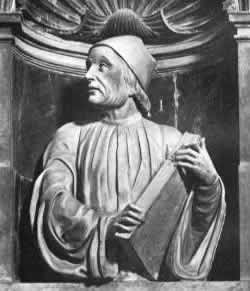 |
| Viking ship |
Vikings were peoples of Scandinavia who raided, conquered, and colonized parts of Europe from the end of the eighth century to the 11th century. Their homeland was in the three modern Scandinavian countries: Denmark, Norway, and Sweden.
The climate there caused poor soil conditions, necessitating seafaring, fishing, and hunting in addition to agriculture. This sparsely populated region was surrounded by water, and various natural resources encouraged trade and contacts; therefore by the Viking age, Scandinavians, apart from Finland and the Sami territories, shared a common culture.
By trading and traveling, Scandinavians were fast in adopting innovations and technologies; therefore their culture was rich and vibrant by the eighth century. Main sources of the history of Vikings are archaeological findings and written records. Most of these texts were written long after the Viking period; therefore their reliability is debated.
The migration period was a time of political, economic, and social change in Scandinavia. At the sites of Helgö or Lake Mälaren, exotic imports appeared, such as gold coins from the Eastern
Roman Empire and a figurine of Buddha from northern India. The last phase of the Iron Age, the Vendel period (seventh–eighth centuries), was the advent of Viking culture; regional centers of power emerged in Scandinavia at this time.
This led to the establishment of the market and craft working centers of Ribe in Denmark and Åhus in Sweden. Christian continental Europe underwent great changes in the eighth century. Social, economic, and political development resulted at first in raids on the monastery of Lindisfarne in the British Isles, and then led to Viking conquests and
colonization in various parts of Europe.
Viking Enterprise and Society Advanced sailing was a prerequisite of Viking age raids and trades. The importance of ships is further demonstrated in their poetry, religion, art, and burial practices. It was not until the eighth century that large Scandinavian vessels were developed.
The oldest known sailing and rowing ship was built around 820 in Oslofjord. Ships were double-ended, with the bow and stern built in the same way. Timber of the smallest possible width was chosen for vessels. This advanced technique resulted in light and seaworthy ships. Cargo ships were shorter and wider and had heavier hulls than warships.
The seagoing trade ship, known as the knarr, relied only on sailing and therefore worked with a small crew. For example a 54-foot-long vessel from Skuldelev could carry as much as 25 tons of cargo. Other cargo ships were excavated in Oslofjord, Göteborg, and Klåstad. Local trade was carried on smaller ships with limited cargo capacity.
Most Scandinavians of the Viking age lived in rural settlements. The main farming activity was animal husbandry; cattle, pigs, sheep, and goats were the most common domesticated species. In the arable lands of southern Sweden and Denmark, barley, rye, oats, peas, beans, and cabbage were cultivated. In Norway, the geographical features of the land led to isolated farm settlements.
Beside the fertile regions of Uppland and Västergötland, a similar pattern could be observed in Sweden. In contrast, small villages were the dominant form of settlements in Denmark. Typically Viking houses were long and accommodated people and animals under the same roof.
Scandinavia did not have real towns before the Viking period, but as a result of accelerating trade and wealth, fairly large and densely populated permanent settlements were created by the 10th century. These settlements had some centralized functions, such as markets, religious and administrative centers, or a mint. Major sources of income were trading and crafting.
Hebedy was one of Scandinavia’s southernmost towns on the eastern side of Jutland. Thanks to the risen water level in the area, which preserved wood and other organic materials, far more is known about this center than any other Viking settlements.
The layout of Hebedy’s wooden-paved streets and fenced plots can be traced in great detail. A semicircular fortifi ed wall protected the town, while protective piles and jetties were found around the harbor as well. Some 350,000 objects were found here, including locally minted coins, leather footwear, glass beads, and jewelry.
Although there is not clear evidence of a royal presence, cemeteries show that there were great class differences in Hebedy. According to written sources the town was destroyed several times in the mid-11th century when the settlement was deserted.
Other towns such as Birka in Sweden or Kaupang in Norway show similar features to Hebedy. In the graves of Birka, the richest graves contained oriental textiles, vessels from the British Isles, and several other luxurious items mainly from the east. Although Kaupang never became a fortified town with large permanent population, it was an important trading post with busy seasonal markets, having regular contacts with Denmark and western Europe.
Scandinavian women played an important role in Viking society and the gender equality of the present-day Scandinavia may originate from those times. Written sources and archaeological findings suggest that women accompanied men in voyages of explorations to Iceland, Greenland, and
North America.
They also went on continental raids and other travels. There is no clear evidence that women ever fought as warriors alongside men. Accompanying women would give useful support for the army, by cooking and nursing the sick and wounded.
The graves of aristocratic women usually contained clothes, jewelry, and domestic implements. When their husbands were away, they had full responsibility of running the house and the farm. Therefore Scandinavian women, especially wealthy ones, exercised great authority over dependents and slaves.
Viking Literature and Art Scandinavia’s own script, the runes, originated from the first or second century. The origin of this writing system is debated, but it is related to Mediterranean alphabets, especially to Roman. The runic alphabet, fupark, originally had 24 characters that were reduced to 16 during the eighth century.
 |
| Vikings village |
The oldest surviving texts were found on jewelry and weapons. Later on the custom of erecting runic stones prevailed to commemorate the dead. Runic scripts often ended with a curse on anyone who moves or destroys the stone.
Viking gods and their power influenced different aspects of Scandinavian life. Religion was also associated with secular leaders. In Scandinavian mythology, there were two families of gods, the æsir and the vanir.
The first included Odin and Thor and the latter Njord and his son Freyr. Freyr’s sister, Freja, was associated with sexuality and fertility. Other gods and goddesses appear in mythology mostly in groups, such as the Valkyries, who were Odin’s servants.
Religious feasts were held in autumn and spring, and according to later textual sources, animals were sacrificed and ale was drunk. Main sources of Scandinavian myths are the medieval copies of Eddic poems, Snorri Sturluson’s Edda, and some of the contemporary stone carvings.
These myths help to encode tabiat life, which was significantly different from the Christian one. All people were free, unless they were enslaved and considered to be the property of others. Viking freedom meant selfdetermination within the community and encouraged a very important feature of contemporary Scandinavian societies: honor.
This was respected by others and maintained peace in a community with limited central power. Vengeance had a function of balance in Viking society. It was the answer to all kinds of offenses, from killing and rape, to wounds. Death, as a punishment, was the same for all and encouraged peace in a society with uneven distribution of wealth.
Viking poetry was essentially oral, but numerous written poems remain and can be divided to three groups: rune poems, eddaic poems, and scaldic verse. Rune poems are brief, written in simple style and meters, praising the dead on rune stones. They date from the end of the 10th century to the 12th century.
Eddaic poems were written in 13th–14th century Iceland and their anonymous authors tell about pagan gods and Scandinavian heroes. Most scaldic poems were carried on through the Icelandic sagas, written down in the 12th–13th centuries. The main theme is to praise certain kings and chieftains on specific occasions.
Scandinavian art used high-quality ornamentation and a great variety of colors. Ornamentation has survived mainly on functional objects, such as clothes, weapons, and ships. The head was a popular motif of sculpting. Gold, silver, and bronze were used to make jewelry for high members of society.
Neck and arm rings were made of gold, while silver was used primarily to inlay patterns of other metals, such as iron. Gold and silver were brought to Scandinavia, usually in the form of coins, from as far as present-day Iraq or the Volga region of Russia. Below the upper class, women and men wore baser materials such as bronze.
Raids on Europe and the Mediteranean  |
| Viking warrior |
From the end of the eighth century Scandinavians pirated, conquered, and colonized western Europe for 300 years. After the early raids on the monasteries of the British Isles, the first recorded attack took place on continental Europe on the island monastery of St. Philibert’s, close to the mouth of Loire, in 799. The nuisance of Scandinavian pirates became serious on both sides of the English Channel and rulers took action against them by the last decade of the eighth century.
The Anglo-Saxons blocked rivers and the Frankish emperor Charlemagne stationed guards on the coasts to prevent Viking upriver attacks. After Charlemagne’s death the empire was driven by internal conflicts and defense weakened.
The Vikings exploited this political weakness quickly, especially after the death of Louis the Pious in 840, and they sailed upriver to penetrate the heart of Francia, sacking major towns, ports, and monasteries. Both Lothair’s and Charles the Bald’s kingdoms were severely attacked by pirates.
In 844 Viking fleets raided Iberia from their first continental base at the mouth of Loire and sacked Lisbon, Cádiz, and Seville. Later on under Hastein and Bjorn Ironsides, they spent the years of 859–862 in the Mediterranean attacking Narbonne, Arles, Pisa, and other towns. Movements after 860 remain uncertain, but in 861 the Muslim fleet off Spain defeated them. The Vikings sailed to the Loire base and never returned to the western Mediterranean.
After 859 Charles the Bald, the king of West Francia, could turn his attention to Vikings; therefore town walls were restored and bridges were fortified. He hired the chief of Somme, Weland, to attack the Seine Vikings in 860. Local leaders could react more quickly than the king; therefore they became the basis of Frankish defense.
These changes turned many Vikings to England, which was divided into small kingdoms with limited cooperation in the ninth century. In 865 a Danish fleet landed in East Anglia and by joining others formed the Great Army.
By 870 Vikings controlled much of eastern England and tried to conquer the last remaining independent kingdom of Wessex. Norse colonists of Anglia had a significant impact on language such as dialects, placenames, and farming vocabulary.
The breakup of the Great Army after its failure to conquer Wessex was followed by the renewed attacks against Francia. Occasionally uniting Viking forces raided the Continent and concentrated on the nonfortified area of the Rhine.
Building fortifications was a successful defense strategy and prevented Vikings from invading Rochester and Paris. Although these measures did not hinder invaders from raiding farther inland, numerous captives and huge quantities of plunder and tribute were taken.
After the defeat of 891 near Louvain, Vikings attempted to conquer West Saxony again without success. This lesson was learned in the British Isles as well. In 896 the Vikings failed to conquer the areas of England not already under their control because more and more fortifications were constructed. In the 10th century possibilities were limited for Vikings in the British Isles.
Wessex was still on the defense in the beginning of the ninth century, but later on, the Vikings experienced defeat after defeat. At that time York was the center of the Scandinavians, but by the 940s the English were severely attacking the lands of the newcomers and took over York in 954.
In Ireland five high kingdoms and several subkingdoms were competing at the beginning of the ninth century. By the 830s raids became much more frequent and a decade later Vikings turned into a permanent presence.
One of the most important new centers was Dublin, a fortified enclosure that became a prosperous merchant and manufacturing town by the 10th century. When Norwegians and Danes settled, they became more vulnerable to counterattack; therefore after the major attacks of 847, many moved to Francia.
After a 40-year resting period Viking activity renewed and soon reached its peak. However Vikings settlements did not live long in Ireland under the constant pressure of the kings of Munster and kings of Meath and the Norse population started to decline by the late 10th century.
Return to England, and Christianization By the end of the 10th century Scandinavian raids renewed on western Europe, especially in England. Under the king Ethelred, the English were able to pay large sums to the Vikings, because the country had a significant quantity of high quality
silver coins.
In 1013 Sweyn decided to conquer England and finished the campaign by the end of the year, probably to prevent the challenge of Thorkell. He was acknowledged as a king but died a few weeks later.
The English recalled Ethelred, but Sweyn’s son, Canute, returned in 1015 and was the king of English, Danes, and Norwegians until his death in 1035. After the successors of Canute died in 1042 Ethelred’s son Edward became the king. He died childless in 1066 and his successor, Harold Godwinson, was challenged by the Norwegian king, Harald Hardrada.
After the fights of the following decades for the Crown, England never again suffered serious Viking attacks. Some Scandinavian raids did continue; however, pirates became more often the victims of such attacks. The Danes especially suffered from serious Slavic raids by the 11th century.




















